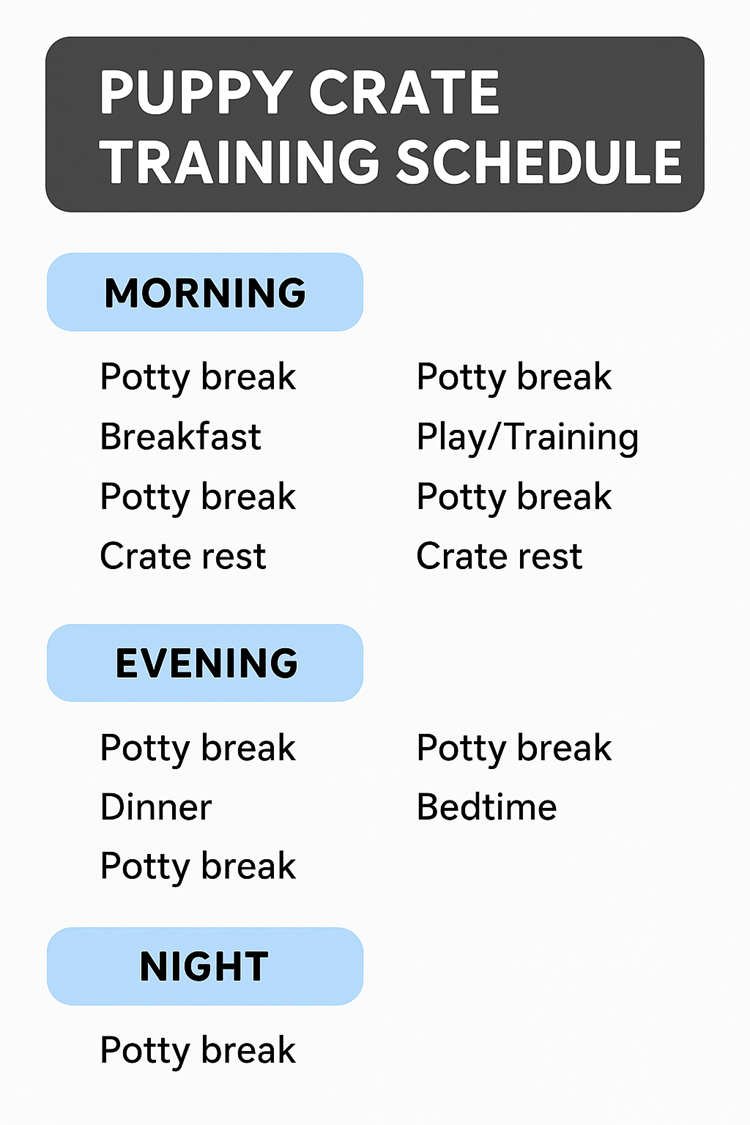Puppy Crate Training Schedule: A Complete Guide for New Dog Owners

Crate training is one of the most effective ways to teach puppies good habits, promote house training, and provide them with a safe, comfortable space. A well-planned puppy crate training schedule not only helps in managing your dog’s behavior but also creates a strong routine that supports long-term discipline and security. If you are a new dog owner, understanding how to create and follow a consistent schedule is key to your puppy’s success.
Why a Puppy Crate Training Schedule is Important
A puppy crate training schedule helps in setting clear expectations for your dog. Puppies thrive on consistency and routine. By introducing a structured daily plan, you are teaching them when to eat, sleep, play, and relieve themselves. This schedule also prevents unwanted behavior such as chewing furniture, barking excessively, or having accidents indoors.
Crates mimic a natural den environment, and when combined with a schedule, they provide both comfort and boundaries for growing puppies.
Factors to Consider Before Starting a Puppy Crate Training Schedule
Before jumping into a routine, there are a few important considerations:
-
Puppy’s Age: Young puppies have smaller bladders and cannot hold it for long periods. The schedule will need to be adjusted based on their age.
-
Crate Size: The crate should be large enough for the puppy to stand, turn, and lie down comfortably, but not so big that they can use one corner as a bathroom.
-
Feeding Times: Regular feeding is essential, as it helps predict when your puppy will need potty breaks.
-
Consistency: Every family member should follow the same puppy crate training schedule to avoid confusion.
Sample Puppy Crate Training Schedule by Age
To help you plan effectively, here is a breakdown of a general schedule for puppies at different stages of growth.
8–10 Weeks Old
-
Morning: Take puppy out of the crate immediately for a potty break. Feed breakfast and then another potty break. Short playtime, followed by crate rest.
-
Daytime: Potty break every 2 hours. Crate naps between play and training sessions.
-
Evening: Dinner followed by potty break. Gentle play and crate time.
-
Night: Last potty break before bedtime. Puppies this age may still need a midnight potty trip.
11–14 Weeks Old
-
Morning: Potty break, breakfast, potty break again. Short crate rest.
-
Daytime: Potty every 3 hours. Increase training and exercise time. Crate naps in between.
-
Evening: Dinner, potty, play, and rest.
-
Night: Potty before bed. Most puppies can now sleep 6–7 hours at night without accidents.
15–20 Weeks Old
-
Morning: Potty and breakfast routine.
-
Daytime: Potty every 4 hours. Training sessions can become longer.
-
Evening: Dinner, potty, and family time outside the crate.
-
Night: Final potty before bedtime.
6 Months and Older
By this stage, your puppy can typically stay in the crate longer between breaks, around 4–6 hours during the day. They usually sleep through the night without interruptions.
How to Make a Puppy Crate Training Schedule Work
1. Establish Consistent Potty Breaks
Always take your puppy outside after waking up, after meals, and after playtime. Following the same timing helps reinforce potty training.
2. Balance Play and Rest
Puppies need plenty of rest, often up to 18–20 hours a day in the early months. A good puppy crate training schedule balances play sessions with naps to prevent overtired behavior.
3. Avoid Long Crate Confinement
While crates are beneficial, keeping a puppy inside for too long can cause anxiety. Use the crate for short rests, training, and bedtime, but not as punishment.
4. Use Feeding to Support the Schedule
Feed your puppy at the same times each day. This consistency makes potty times predictable, helping the crate training process.
5. Reward Good Behavior
Whenever your puppy follows the schedule correctly—such as settling in the crate quietly or going potty outside—reward with praise or small treats.
Common Mistakes in Puppy Crate Training Schedule
-
Using the crate for punishment: This creates fear instead of comfort.
-
Leaving the puppy inside too long: This can lead to accidents and stress.
-
Inconsistency: Skipping breaks or changing the schedule often confuses the puppy.
-
Ignoring exercise needs: Puppies with excess energy may resist the crate.
Benefits of Following a Puppy Crate Training Schedule
-
House Training Success: Puppies learn where and when to go potty.
-
Safety: Prevents chewing hazards and accidents when unsupervised.
-
Routine: Encourages healthy eating, sleeping, and play habits.
-
Travel and Vet Visits: A crate-trained puppy adapts better to new environments.
Tips to Adjust the Puppy Crate Training Schedule
Every puppy is different. You may need to adjust the schedule based on:
-
Your puppy’s breed (smaller breeds may need more breaks).
-
Your work schedule or family lifestyle.
-
The puppy’s health and activity levels.
Flexibility is important, but consistency remains the foundation of successful crate training.
FAQs on Puppy Crate Training Schedule
Q1: How long can a puppy stay in a crate?
The general rule is one hour per month of age, up to a maximum of 4–5 hours during the day. For example, a 3-month-old puppy should not be crated for more than 3 hours at a time.
Q2: Should I feed my puppy inside the crate?
Yes, feeding inside the crate helps create positive associations, but always remove the food bowl afterward.
Q3: What if my puppy cries in the crate?
Crying is normal at first. Do not immediately let them out, as this reinforces the behavior. Ensure they are not hungry, need to potty, or uncomfortable before ignoring mild whining.
Q4: Can I crate train an older puppy or adult dog?
Yes, a puppy crate training schedule works at any age, though younger dogs may adjust faster. Older dogs may require more patience and gradual training.
Q5: How do I know if the schedule is working?
Signs of progress include fewer indoor accidents, the puppy settling calmly in the crate, and predictable potty routines.
Final Thoughts on Puppy Crate Training Schedule
A puppy crate training schedule is not just about keeping your dog confined—it is about teaching discipline, safety, and comfort. By following a consistent routine that balances potty breaks, playtime, feeding, and crate rest, you help your puppy build lifelong good habits. Patience and consistency are key. Over time, your dog will see the crate as a safe, welcoming space rather than a restriction.
With the right puppy crate training schedule, you are setting your furry friend up for success, ensuring they grow into a well-mannered and happy companion.





